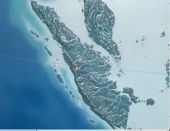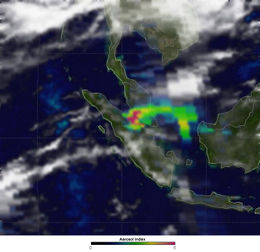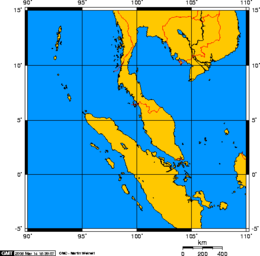Strait of Malacca
2007 Schools Wikipedia Selection. Related subjects: General Geography

The Strait of Malacca (also called the Straits of Malacca, and in Malay Selat Melaka) is a narrow stretch of water between Peninsular Malaysia (West Malaysia) and the Indonesian island of Sumatra. It is located around .
Economic importance of the Strait
From an economic and strategic perspective the Strait of Malacca is one of the most important shipping lanes in the world, an equivalent of the Suez Canal, or the Panama Canal. The Strait forms the main ship passageway between the Indian Ocean and the Pacific Ocean, linking three of the world's most populous nations: India, Indonesia and China. The Strait carries 50,000 vessels per year, carrying between one-fifth and one quarter of the world's sea trade. A quarter of all oil shipments carried by sea come through the Strait, in 2003, an estimated 11 million barrels (1,700,000 m³) a day, a trade that is expected to expand as oil consumption rises in China. At Phillips Channel near Singapore, the 805 km (500 mile) channel is only 1.5 nautical miles (2.8 km) wide at its narrowest point. This creates one of the world's most significant traffic bottlenecks . The maximum size of a vessel that can make passage through the Strait is referred to as Malaccamax.
All these factors have caused the area to become a target for piracy and a perceived target for terrorism. Piracy has been a considerable problem in the Strait in recent years, rising from around 25 attacks in 1994 to a record 220 in 2000. Just over 150 attacks were carried out in 2003. This accounted for around one-third of all piracy in 2003.
The number of attacks rose again in the first half of 2004, and the total number is expected to top the 2000 record. In response to the rising crisis, the Malaysian, Indonesian and Singaporean navies stepped up their patrols of the area in July 2004.
Fears of terrorism rest on the possibility that a large ship could be pirated and sunk at a shallow point in the Strait (it is just 25m deep at its shallowest part), effectively blocking the Strait. If successfully achieved, the attack would have a devastating effect on world trade. Opinions amongst security specialists differ about the feasibility and likelihood of such an attack.
The 34 shipwrecks located in the busy waterway of the Straits of Malacca are worrying to ships plying the busy sea passage. The sunken vessels, some dating back to the 1880s, are all located in the Traffic Separation Scheme (TSS), the imaginary sealane for commercial ships. Mariners are concerned because the shipping channel is narrow in some areas and has irregular depths, shallow areas and shifting sand banks and mud flaps.
Another shipping risk in the Straits is the yearly haze that persists due to raging bush fires in Sumatra. The haze can choke shipping by reducing visibility to as low as 200m making navigation in such a narrow and busy trade route hazardous.
There is also the perceived risk that terrorist or pirates could make use of the cover of haze to their advantage in launching operations.
Proposals to relieve the Strait
Thailand has developed several plans that if implemented would diminish the economic significance of the Strait. The Thai government has over the course of its history several times proposed to cut a canal through the Isthmus of Kra, shaving around 600 miles from the journey from Africa and the Middle East to the Pacific. This would effectively cut Thailand in two, further isolating the separatist Muslim majority in Pattani. The prohibitive financial and ecological costs suggest that no such canal will go ahead in the near future despite the backing of several Thai politicians, and according to a report leaked to The Washington Times in 2004, the offer by China to underwrite the costs of the canal. A second alternative is to build a pipeline across the isthmus to carry oil to ships waiting on the other side. Proponents of the plan say it would cut the cost of oil delivery to Asia by about $0.50/barrel ($3/m³). Myanmar has also made a similar pipeline proposal. Finally, there is also a proposal to directly pipe crude from the Middle East to Xinjiang, China. Building began in October 2004.
Early sea routes
Early traders from Egypt, Rome, Arabia, Africa, Turkey, Persia and India used to reach the Malaysian state of Kedah before arriving at Guangzhou. Kedah served as a western port on the Malay Peninsula. These traders were brought into Kedah by the monsoon trade winds between June through November. They returned between December through May. Kedah provided accommodations, porters, small vessels, bamboo rafts, elephants and also tax collections, for goods to be transported over land toward the eastern states of the Malay Peninsula like Kelantan. Ships from China came to trade at these eastern trading posts and ports. Kedah and Funan were famous ports through the 6th century, before the usage of the Straits of Malacca as a trade route.


